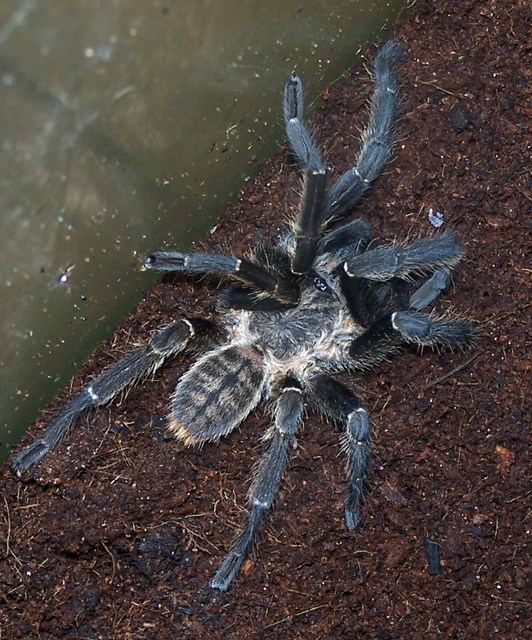Kingdom Animalia Class Arachnida Infraorder Mygalomorphae Phylum Arthropoda Rank Species | Subphylum Chelicerata Order Araneae Family Theraphosidae Genus Haplopelma | |
 | ||
Similar Haplopelma, Haplopelma schmidti, Ornithoctonus, Haplopelma albostriatum, Ornithoctoninae | ||
Haplopelma hainanum hunting a cricket
Haplopelma hainanum is a species of spider in the family Theraphosidae (tarantulas), found in China. It is one of a number of species from China and Vietnam known as "Chinese bird spider". It produces a venom that contains numerous compounds capable of blocking neurotransmitters, including neurotoxic peptides called hainantoxins.
Contents
- Haplopelma hainanum hunting a cricket
- Haplopelma hainanum new arrival update and shoutouts
- Description
- Taxonomy
- Distribution and habitat
- Toxicity
- References
Haplopelma hainanum new arrival update and shoutouts
Description
Haplopelma hainanum resembles H. schmidti, but can be distinguished by its dark black-brown body and the longer length of the "thorns" on the forward-facing (prolateral) side of the maxillae. The carapace (upper surface of the cephalothorax is black-brown, the sternum (under surface of the cephalothorax being red-brown; the abdomen is dark brown, with six black stripes running across it and a black stripe down the centre of the upper surface.
The female is about 60 mm long (body plus chelicerae). The first leg is longest, at about 67 mm, the third being the shortest, at about 51 mm. The spermatheca is M-shaped. The male is smaller, about 34 mm long (body plus chelicerae). The fourth leg is the longest, at about 61 mm, the third being the shortest, at about 47 mm. Thus although the body is significantly smaller than that of the female, the male's legs are of a similar length. The tibia of the first leg has a spur on the forward-facing side. The palpal bulb is pear-shaped, with a wide curved embolus.
Haplopelma hainanum makes underground burrows, lined with silk, and often with silk alarm lines radiating from the mouth. The spider remains in its burrow during the day, emerging only at night to catch prey, mainly large insects.
Taxonomy
Haplopelma hainanum was first described, as Selenocosmia hainana, by S. P. Liang et al. in 1999. In 2001, M. S. Zhu et al. transferred the species to the genus Ornithoctonus. In 2003, Gunter Schmidt placed the species in the genus Haplopelma, where it remains.
Distribution and habitat
Haplopelma hainanum is only known from Hainan, an island off the mainland of southern China. It is found in south-facing mountain slopes, steeply sloping at 75˚ to 85˚.
Toxicity
Its venom is the subject of toxicology research, and while the effects of this spider's bite on man are not well documented it is frequently lethal in small doses to laboratory animals such as mice and rats. As a result, Haplopelma hainanum is generally regarded as a highly venomous species. The venom is a complex neurotoxin, containing numerous compounds capable of blocking neurotransmitters, including neurotoxic peptides called hainantoxins.
